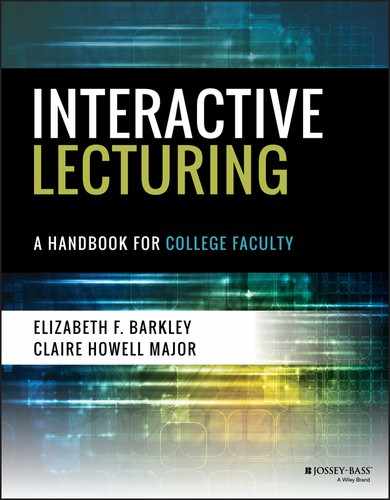ENGAGING LECTURE TIP 49
Right Means Right
We have been in classroom situations in which we have asked a question, a student responds, and the answer the student gives is simply wrong. We have also observed this in other teachers' classrooms. We all struggle with how to handle it. Our responses run the gamut from “Well that's an interesting point. Does anyone else have a thought about this?” to “Right. Um. Okay. Well, thank you.” Most of us want to reinforce participation and not shut the student down. Indeed, the classroom needs to be a safe place for participation.
There are consequences, however, to not acknowledging that an answer is simply wrong. First, you can reinforce the student's misunderstanding if you don't correct the error. Second, you can affirm incorrect information to the rest of the class. Third, you can lose the students who do know the right answer. For these reasons, we suggest that you adopt a Right Means Right stance.
Having a few responses available that you can use as needed can help you to uphold the standards of Right Means Right. Following are some common ways answers are incorrect, or at least not fully correct, with some sample responses.
Vague or Incomplete Answer
Probe for more information by using questions such as the following:
- Could you give me an example of what you mean?
- Could you elaborate on that point?
- Could you explain how you got to that answer?
- That's good so far. Can you finish the last part?
- Okay, but there's more to the answer than that.
These questions also work well for correct answers.
Partially Correct Answer
Highlight the part that is correct and clarify where the answer is wrong. Consider the following sample responses:
- You are correct about x, and that's great; but you're wrong about y. So we need to correct y so we have a fully accurate answer, and here's how we can do that.
- I'm with you on x, but you lost me on y. Let's figure this out.
- Right, except you forgot x. So when we consider x, we get a fully correct answer.
Wrong Answer
State that it's wrong and offer a correction. Consider the following sample answers:
- Thanks for giving it a try. That's a really common misconception or mistake. Let's consider why that is . . .
- I'm glad you made that mistake. Many students make the same one, and here's the reason for that . . .
- Actually, I think you forgot to consider a few facts that might change your answer. What about x, y, and z? What do you think now?
- Okay, that's an example. I asked for the definition. Can you provide that?
- Oh, that's very close, but it's not quite right. Who can tell me the correct name?
- That would be correct if x were true, but this situation is different because of y.
- I see why you might think that because these two concepts are easy to confuse. However, we're talking about x specifically and not y.
- No, but thank you for trying.
Sometimes a wrong answer says something about the way you have phrased the question. You may want to rephrase it before you move to another student contributor, and you will most certainly want to rethink it before asking the question the same way in future sessions.
Many times when a student provides a wrong answer you gain some insight into how students may be thinking about the question. You can use this opportunity to move students toward a better understanding.
The trick to following Right Means Right is knowing the students and understanding which type of response will work the best in the given situation.
Example
Key References and Resources
- Hunter, M. (1982). Mastery teaching: Increasing instructional effectiveness in secondary schools, colleges, and universities. El Segundo, CA: TIP Publications.
- Lemov, D. (2010). Teach like a champion: 49 strategies that put students on the path to success. San Francisco, CA: Jossey-Bass.
- University of Michigan, Center for Research on Teaching and Learning. (n.d.b). Classroom challenge: Handling wrong answers. Retrieved from www.crlt.umich.edu/node/712
- Weimer, M. (2008). Ways of responding to wrong or not very good answers. Faculty Focus. Retrieved from www.facultyfocus.com/articles/teaching-and-learning/ways-of-responding-to-a-wrong-or-not-very-good-answers/
